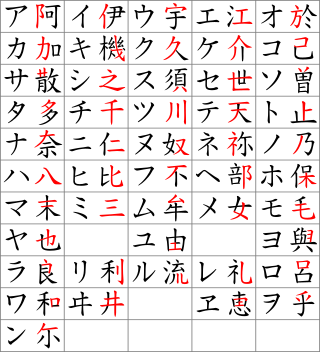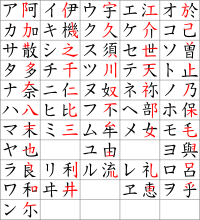Man'yōgana
System of writing Japanese based solely on Chinese characters From Wikipedia, the free encyclopedia
Man'yōgana (万葉仮名, Japanese pronunciation: [maɰ̃joꜜːɡana] or [maɰ̃joːɡana]) is an ancient writing system that uses Chinese characters to represent the Japanese language. It was the first known kana system to be developed as a means to represent the Japanese language phonetically. The date of the earliest usage of this type of kana is not clear, but it was in use since at least the mid-7th century. The name "man'yōgana" derives from the Man'yōshū, a Japanese poetry anthology from the Nara period written with man'yōgana.
This article needs additional citations for verification. (November 2022) |
Texts using the system also often use Chinese characters for their meaning, but man'yōgana refers to such characters only when they are used to represent a phonetic value. The values were derived from the contemporary Chinese pronunciation, but native Japanese readings of the character were also sometimes used. For example, 木 (whose character means 'tree') could represent /mo/ (based on Middle Chinese [məwk]), /ko/, or /kwi/ (meaning 'tree' in Old Japanese).[1]
Simplified versions of man'yōgana eventually gave rise to both the hiragana and katakana scripts, which are used in Modern Japanese.[2]
Origin
Scholars from the Korean kingdom of Baekje are believed to have introduced the man'yōgana writing system to the Japanese archipelago. The chronicles Kojiki and the Nihon Shoki both state so; though direct evidence is hard to come by, scholars tend to accept the idea.[3]
A possible oldest example of man'yōgana is the iron Inariyama Sword, which was excavated at the Inariyama Kofun in 1968. In 1978, X-ray analysis revealed a gold-inlaid inscription consisting of at least 115 Chinese characters, and this text, written in Chinese, included Japanese personal names, which were written for names in a phonetic language. This sword is thought to have been made in the year 辛亥年 (471 AD in the commonly-accepted theory).[4]
There is a strong possibility that the inscription of the Inariyama Sword may be written in a version of the Chinese language used in Baekje.[5]
Principles
Summarize
Perspective
Man'yōgana uses kanji characters for their phonetic rather than semantic qualities. In other words, kanji are used for their sounds, not their meanings. There was no standard system for choice of kanji, and different ones could be used to represent the same sound, with the choice made on the whims of the writer. By the end of the 8th century, 970 kanji were in use to represent the 90 morae of Japanese.[6] For example, the Man'yōshū poem 17/4025 was written as follows:
| Man'yōgana | 之乎路可良 | 多太古要久礼婆 | 波久比能海 | 安佐奈藝思多理 | 船梶母我毛 |
|---|---|---|---|---|---|
| Katakana | シオジカラ | タダコエクレバ | ハクヒノウミ | アサナギシタリ | フネカジモガモ |
| Modern | 志雄路から | ただ越え来れば | 羽咋の海 | 朝凪したり | 船梶もがも |
| Romanized | Shioji kara | tadakoe kureba | Hakuhi no umi | asanagi shitari | funekaji mogamo |
| Translation | From the Shiotsu road, | As I simply cross over, | The sea of Hakui | Is calm in the morning stillness. | Oh, if only I had a ship's rudder. |
In the poem, the sounds mo (母, 毛) and shi (之, 思) are written with multiple, different characters. All particles and most words are represented phonetically (多太 tada, 安佐 asa), but the words ji (路), umi (海) and funekaji (船梶) are rendered semantically.
In some cases, specific syllables in particular words are consistently represented by specific characters. That usage is known as Jōdai Tokushu Kanazukai and usage has led historical linguists to conclude that certain disparate sounds in Old Japanese, consistently represented by differing sets of man'yōgana characters, may have merged since then.
Types
Summarize
Perspective
In writing which utilizes man'yōgana, kanji are mapped to sounds in a number of different ways, some of which are straightforward and others which are less so.
Shakuon kana (借音仮名) are based on a Sino-Japanese on'yomi reading, in which one character represents either one mora or two morae.[7]
| Morae | 1 character, complete | 1 character, partial |
|---|---|---|
| 1 | 以 (い) 呂 (ろ) 波 (は) | 安 (あ) 樂 (ら) 天 (て) |
| 2 | 信 (しな) 覧 (らむ) 相 (さが) | |
Shakkun kana (借訓仮名) are based on a native kun'yomi reading, one to three characters represent one to three morae.[7]
| Morae | 1 character, complete | 1 character, partial | 2 characters | 3 characters |
|---|---|---|---|---|
| 1 | 女 (め) 毛 (け) 蚊 (か) | 石 (し) 跡 (と) 市 (ち) | 嗚呼 (あ) 五十 (い) 可愛 (え) 二二 (し) 蜂音 (ぶ) | |
| 2 | 蟻 (あり) 卷 (まく) 鴨 (かも) | 八十一 (くく) 神樂聲 (ささ) | ||
| 3 | 慍 (いかり) 下 (おろし) 炊 (かしき) | |||
| – | K | S | T | N | P | M | Y | R | W | G | Z | D | B | |
|---|---|---|---|---|---|---|---|---|---|---|---|---|---|---|
| a | 阿安英足鞅 | 可何加架香蚊迦 | 左佐沙作者柴紗草散 | 太多他丹駄田手立 | 那男奈南寧難七名魚菜 | 八方芳房半伴倍泊波婆破薄播幡羽早者速葉歯 | 萬末馬麻摩磨満前真間鬼 | 也移夜楊耶埜八矢屋 | 良浪郎樂羅等 | 和丸輪 | 我何賀 | 社射謝耶奢装蔵 | 陀太大嚢 | 伐婆磨魔 |
| i1 | 伊怡以異已移射五 | 氣支伎岐企棄寸吉杵來 | 子之芝水四司詞斯志思信偲寺侍時歌詩師紫新旨指次此死事准磯爲 | 知智陳千乳血茅 | 二貳人日仁爾儞邇尼泥耳柔丹荷似煮煎 | 比必卑賓日氷飯負嬪臂避匱 | 民彌美三參水見視御 | 里理利梨隣入煎 | 位爲謂井猪藍 | 伎祇藝岐儀蟻 | 自士仕司時尽慈耳餌兒貳爾 | 遅治地恥尼泥 | 婢鼻彌 | |
| i2 | 貴紀記奇寄忌幾木城 | 非悲斐火肥飛樋干乾彼被秘 | 未味尾微身実箕 | 疑宜義擬 | 備肥飛乾眉媚 | |||||||||
| u | 宇羽汙于有卯鴉得 | 久九口壟苦鳩來 | 寸須周酒州洲珠數酢栖渚 | 都豆荳通追川津 | 奴努怒農濃沼宿 | 不否布負部敷経歴 | 牟武無模務謀六 | 由喩遊湯 | 留流類 | 具遇隅求愚虞 | 受授殊儒 | 豆荳頭弩 | 夫扶府文柔歩部 | |
| e1 | 衣依愛榎 | 祁家計係價結鶏 | 世西斉勢施背脊迫瀬 | 堤天帝底手代直 | 禰尼泥年根宿 | 平反返弁弊陛遍覇部辺重隔 | 売馬面女 | 曳延要遙叡兄江吉枝衣 | 禮列例烈連 | 廻恵面咲 | 下牙雅夏 | 是湍 | 代田泥庭傳殿而涅提弟 | 弁便別部 |
| e2 | 氣既毛飼消 | 閉倍陪拝戸経 | 梅米迷昧目眼海 | 義氣宜礙削 | 倍毎 | |||||||||
| o1 | 意憶於應 | 古姑枯故侯孤兒粉 | 宗祖素蘇十拾 | 刀土斗度戸利速 | 努怒農埜 | 凡方抱朋倍保宝富百帆穂本 | 毛畝蒙木問聞 | 用容欲夜 | 路漏 | 乎呼遠鳥怨越少小尾麻男緒雄 | 吾呉胡娯後籠兒悟誤 | 俗 | 土度渡奴怒 | 煩菩番蕃 |
| o2 | 己巨去居忌許虛興木 | 所則曾僧増憎衣背苑 | 止等登澄得騰十鳥常跡 | 乃能笑荷 | 方面忘母文茂記勿物望門喪裳藻 | 與余四世代吉 | 呂侶 | 其期碁語御馭凝 | 序叙賊存茹鋤 | 特藤騰等耐抒杼 |
Development
Summarize
Perspective
Due to the major differences between the Japanese language (which was polysyllabic) and the Chinese language (which was monosyllabic) from which kanji came, man'yōgana proved to be very cumbersome to read and write. As stated earlier, since kanji has two different sets of pronunciation, one based on Sino-Japanese pronunciation and the other on native Japanese pronunciation, it was difficult to determine whether a certain character was used to represent its pronunciation or its meaning, i.e., whether it was man'yōgana or actual kanji, or both.[citation needed] To alleviate the confusion and to save time writing, kanji that were used as man'yōgana eventually gave rise to hiragana, including the now-obsolete hentaigana (変体仮名) alternatives, alongside a separate system that became katakana. Hiragana developed from man'yōgana written in the highly cursive sōsho (草書) style popularly used by women; meanwhile, katakana was developed by Buddhist monks as a form of shorthand, utilizing, in most cases, only fragments (for example, usually the first or last few strokes) of man'yōgana characters. In some cases, one man'yōgana character for a given syllable gave rise to a hentaigana that was simplified further to result in the current hiragana character, while a different man'yōgana character was the source for the current katakana equivalent. For example, the hiragana る (ru) is derived from the man'yōgana 留, whereas the katakana ル (ru) is derived from the man'yōgana 流. The multiple alternative hiragana forms for a single syllable were ultimately standardized in 1900, and the rejected variants are now known as hentaigana.
Man'yōgana continues to appear in some regional names of present-day Japan, especially in Kyūshū.[citation needed][8] A phenomenon similar to man'yōgana, called ateji (当て字), still occurs, where words (including loanwords) are spelled out using kanji for their phonetic value. Examples include 倶楽部 (kurabu, "club"), 仏蘭西 (Furansu, France), 阿弗利加 (Afurika, Africa) and 亜米利加 (Amerika, America).


See also
- Syllabogram
- Sōgana – Archaic Japanese syllabary
- Idu script, Korean analogue
References
External links
Wikiwand - on
Seamless Wikipedia browsing. On steroids.

